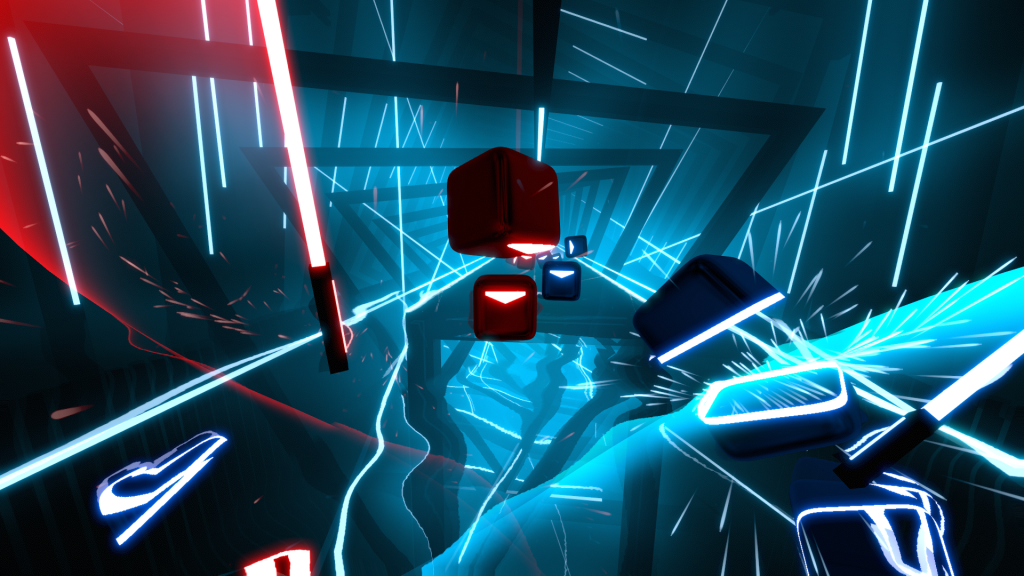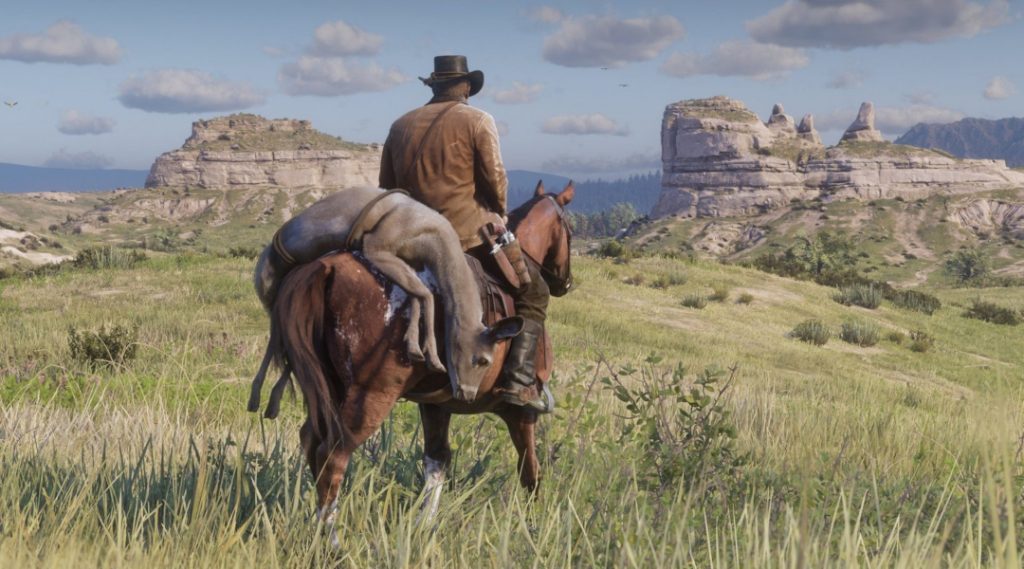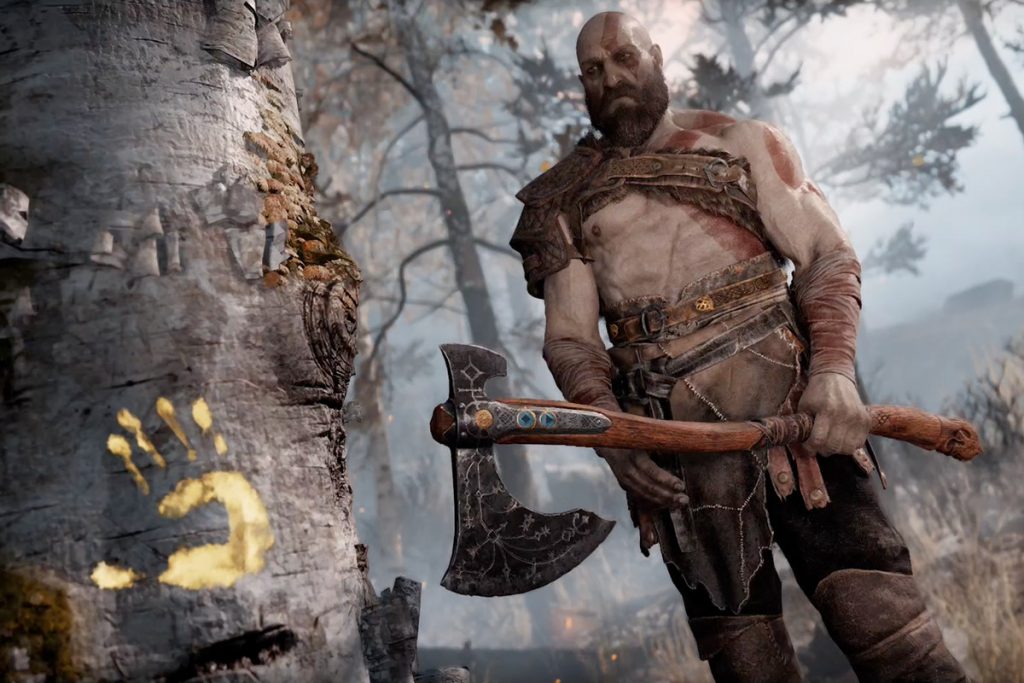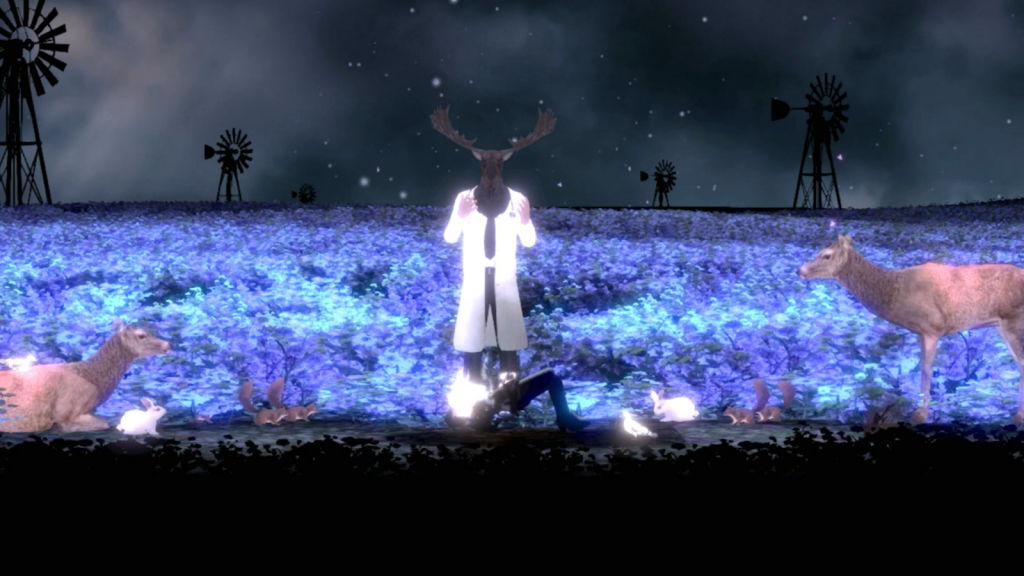bluexy’s Top 10 Games of 2018
Welcome back to another year of Rory wondering how in the hell he’s supposed to put his favorite games in any sensical ordering, also known as Game of the Year 2018. As seems to be increasingly the case, 2018 was filled to the brim with an astonishingly diverse range of excellent games. Independently developed titles continue to be the most common source of such diversity, a constant stream of experimental ideas, and so they remain the most appealing to my curiosity. While AAA gaming in 2018 may have felt less inspired than previous years, no one can question what qualities a roster of exceptional developers can manage with a terrifying budget. As such, in 2018 I looked towards AAA games for the larger than life storytelling that indies found out of reach. A diet of both makes for a healthy year.
And of course, the more games one plays, the more value there is in targeting a diverse range of experiences. In 2018 I played over 40 games, falling short of my 2017 and 2016 totals which were both well over 50. But 2018 was a bit odd in some respects, and also I played way too much Sea of Thieves, Destiny 2, and World of Warcraft‘s Battle for Azeroth expansion. While just over 40 still feels like less than I’d want, I also feel like I managed to better focus on games I knew would be worth playing at the same time. As such, I’m still confident in my Top 10 and that I did get to play everything I wanted to.
Overall, I’m not sure how 2018 will compare to previous years. The best games of the year aren’t even particularly flashy, let alone genre-defining. Time will tell. But I’m absolutely positive that every game on my list is great, and so carries my personal recommendation. Please enjoy.

10. Beat Saber
Beat Saber is a perfect example of a virtual reality game that understands its medium to a degree above its competition. Like past popular rhythm games Rock Band and Guitar Hero, in Beat Saber beats will fly towards the player. Only now, they’re literally flying towards you. And instead of pressing a button in time with the rhythm, players slash through the beats with 1:1 motion controls. It’s exceptionally simple, doesn’t push players into mechanics where VR is still experimental or unpolished, and reaches a level of difficulty so both new and experienced game players can have fun. It is easily one of VR’s definitive experiences.
On PC, Beat Saber remains in Early Access. And to be honest I’d hoped it’d remain there for some time. While Beat Saber is impressive in its simplicity, an added layer of story or adventure could make it even better. Even just a selection of great themed songs might be enough. But all the same, the game did come out on PlayStation 4 as-is and so can’t be denied its place here. Beat Saber is a great game right now, but also has so much potential as a franchise going forward.
9. Far: Lone Sails
Just two games in and already a pattern of repetitive, yet compelling, gameplay is emerging. Far: Lone Sails is a journey unlike any other. The player spends the bulk of the game performing on-the-move maintenance on this hulking machine that’s barely holding together as it rolls through a wasteland. Every second it continues moving forward is a miracle, which is why performing mundane tasks like refueling, expelling steam, and accelerating never feel like a chore. They feel like survival.
Many will look to Far: Lone Sails‘ excellent atmosphere and scenery as its strongest asset. And by all means, it is impressive. The cold and empty world that passes by tells a haunting story. But that story, as well as most of the game’s artistic decisions like how the camera allowed little to no vision of what was ahead or behind the player, served only to help me focus on character and the machine itself. This is what matters. What’s to come and what’s been left behind are cursory. Just keep this big metal piece of junk rolling forward.
Far: Lone Sails is beautiful in its simplicity. And the ending captures all of those feelings and throws them back at you in a poignant and hopeful way. This game has lingered with me perhaps more than any other game on my list.

8. Red Dead Redemption 2
What’s left to say about Red Dead Redemption 2? Rockstar’s latest open-world western game is about as big as games get these days. But that’s not how Red Dead 2 made my list. I’m not really a fan of the game’s open world or the seemingly endless stream of side-quests, mini-games, and tedious exploration. But I am a huge fan of the game’s performances. It’s some of the best work the industry has ever seen.
The story itself is a lengthy, overwrought thing filled with endless betrayal and gunfights — a fitting if not ultimately compelling story for an action game. But it does provide plenty of opportunities for the members of Dutch’s gang, and both Arthur and Dutch particularly, to act out scene after scene filled with raw emotion and drama. It’s these performances that make the near-ridiculousness of Red Dead Redemption 2‘s gameplay grounded. It’s what makes the game work at all. And it’s absolutely what makes what’s likely to be 2018’s best selling game worth remembering in the years to come.
If only it didn’t have all that extra bulk that doesn’t ultimately add to the overall experience.
7. BattleTech
Playing BattleTech reminded me of a feeling I haven’t experienced since the 90s when I played Dune II, Command & Conquer: Red Alert 2, and StarCraft. Completely different games than BattleTech, right? And yet the feeling was the same. What BattleTech did was make me feel like a very small but significant part of the universe around. Like every mission carried with it a level of consequence just beyond my periphery. And that combination of significance and consequence made every mission rich and tense, challenging and with purpose, in ways that games rarely manage anymore.
Unfortunately, BattleTech also did its best to derail that momentum with repetitive, uninspired mission design and what may as well have been randomized, uninspired mechs. But you have to take the bad with the good with old franchises like BattleTech, and in the 2018 version of the game there’s very much a lot of good to appreciate.

6. God of War
Like with Red Dead Redemption 2, half of what makes God of War great are the performances, particularly by Kratos and Freya. The game’s characters are brought to life in such an incredible way, a mixture of voice acting, motion capture, and animation — truly a studio-wide effort.
But God of War also tells a deeply personal about growth and legacy. It’s certainly not perfect, often struggling to escape the franchise’s lazy reliance on excessive violence, but all the same the development team’s passion for doing something new and meaningful is obvious.
There are two reasons God of War isn’t higher on my list. First is one of the final sequences involving Freya and her son, which exceeds my tolerance level of “problematic” and delves into sheerly unfortunate decisionmaking. And then there’s the game’s conclusion, which overloads the player with so many attention-grabbing questions that the true capstone on Kratos and his son’s journey is robbed of much of its emotion. The burdens of being the lead-in of a new series of games, I suppose.
5. Celeste
I climbed a mountain and I loved it. Celeste brings with it such pure intentions that it’s impossible not to adore. The story of a young girl both figuratively and literally climbing a mountain, struggling with ghosts and manifestations of her own fears and faults, but also finding friendship, courage, and personal acceptance. It’s a modern-day fable, beautifully presented and told.
Like Shovel Knight years ago, Celeste puts together an amazing retro experience that’s instilled with the design values of so many great games that have come before it in its genre. The 2D platforming feels incredibly responsive and smooth, deserving comparisons to Super Meat Boy. Unlike Shovel Knight, but still like Super Meat Boy, Celeste spins off a good amount of content into non-required bonus levels. And while I think that works for Super Meat Boy, which is very much a self-aware video game, I would have preferred Celeste build all of that amazing level design into its world and story in a more natural and meaningful way. I think Shovel Knight is a great example of putting all of your best work into the heart of the game, whereas Celeste turns it into a bit of a trade-off. I’d rather not play that extra content even though I know it’s exceptional if it’s going to ultimately detract from my overall experience
I believe that the main story, as well as the overall polish of Celeste (that soundtrack) more than makes up for my criticism, however. Just not quite enough to move it up a rank.

4. Gris
I feel horrible having to make this comparison, but Gris, to me, is great in virtually all of the same ways that Celeste is, only I found Gris to be a touch better across the board — a touch more meaningful, a touch more efficacious. Gris is an example of my preference for games that manage to do concisely and purposefully what other games tend to obfuscate or delay to extend gameplay. I felt like the time I spent with Gris was perfect, that the punch of the ending came just in time, and that I ultimately left the game carrying with me the full emotional impact of its story, knowing my experience is complete.
What was that experience? It started with Gris‘ stunning painterly world. From moment one, every step forward in Gris is beautifully rendered, to the point of seeming created entirely by hand. The use of color and the constant movement in both the foreground and background draws the player in. Just another Gris cultivates an emotional atmosphere.
And that atmosphere may be my favorite aspect of Gris. Each zone in the platformer resounded within me. The feeling of loss and confusion, as if pillars of the identity had toppled overnight, becoming feelings of growth and healing, and ultimately life-affirming acceptance, all stood out with profundity. Even the terror of Gris, the crow, the eel, the sadness and fear that was always there just below the surface, was used exceptionally and carefully. I absolutely adore Gris.
3. Sea of Thieves
And now for something completely different. Sea of Thieves is by far the most “game-y” inclusion on my top 10 of 2018. The intent of its creation, like many games in recent years, is to provide a fun and adventurous experience that can be shared with friends, to provide a unique platform for emergent experiences. A rather mundane aspiration that entirely depends on execution, polish, and an exceptional understanding of player needs, an extreme dedication to meeting them. Sea of Thieves does that.
What happens when players load into Sea of Thieves, walk towards the beach and see their first ship is so magical that those ideas about what this game can or should be melt away. It’s so simple and natural to become a pirate in Sea of Thieves. There’s got to be some magic in Rare’s code, because the gameplay is simple enough to be intuitive yet complex enough to reward players who let themselves fully embrace the roleplay. And it really is a required subtle roleplay, as players slide in and out of the roles required to efficiently manage a ship. It’s so rare for this type of game so wholly embrace its concept, but it works — Sea of Thieves is the definitive jolly pirate experience.
As befits such a game, the true diamond at the heart of Sea of Thieves are the stories I’ve garnered along the way. I sailed the Sea with a crew of three pre-teens. I taught them how to keep a well-stocked ship and then unleashed them upon a 4-ship battle at a Skull Fort. They were relentless and brutal and we won the day without me stepping off of the ship. I served under an elderly roleplaying captain who demanded I call him Captain Squinty and made me swim laps around the boat if I gave him sass. I spent six rallying the crews of several different galleons, instructing them on how to shoot themselves out of a cannon to land on an empty skeleton throne perched high above along a cliffside. I did so many things in Sea of Thieves and all of them were wonderful. It’s truly a game for anyone to play the pirate they want to be.

2. The Missing: J.J. Macfield and the Island of Memories
Here’s where I know I’m going to contradict myself trying to explain just how excellent The Missing is. Let’s start with the harsh truth of the matter. The Missing doesn’t have fun or even well-executed gameplay. The puzzles are often more boring and tedious than interesting. The way JJ explodes is unreliable and frustrating. Certain levels feel like they can go on forever. And that’s why it’s my second best game of 2018. Okay, there’s maybe a bit more to it.
What The Missing does is say something. What The Missing does is make a point. And in 2018, I can’t tell you how unbelievably rare, brave, and just… completely, explosively, meaningful a game like The Missing is.
Bordering on virtual transgressive art, The Missing employs gameplay in which JJ dismembers herself in increasingly violent ways to overcome the obstacles in front of her, to progress towards the symbol of love, support, and acceptance in her life — her love, Emily. Though in this nightmarescape, even Emily’s been twisted by JJ’s fear and confusion. This isn’t meant to be a clever mechanic or cheap effort at evoking sympathy, though, it’s symbolic of JJ’s struggle with mental and emotional abuse from her mother, as well as her struggle with depression and dysphoria. It’s a deeply unsettling sort of gameplay, punctuated by how awful it is to manage from a strictly mechanical point of view. It’s necessary and effective.
The game’s conclusion, which reveals that JJ is a gay trans woman, isn’t at all a twist or surprise. The game has spent the hours preceding this moment building an honest and realistic state of emotional participation in JJ’s life with the player. Where a twist ending is like having your feet pulled out from under you, The Missing‘s is like finding the light switch in a dark room. The ending is understanding. And it is powerful.

1. Florence
Florence, my game of the year, is exceptional in its empathy. Which is all the more magnificent because of the game’s small story and simple gameplay.
In Florence, all that’s required of the player is small actions and motions, most of which are commonplace for those using their phones. It’s this comfort, this familiarity with the routine that allows Florence to immediately establish a connection between the player and the game’s 25-year old protagonist. But also, more subtly, the game starts building up empathy with the player in the space in-between. In the first chapter alone, Florence and the player experience several notable emotional moments, including an implied loneliness looking at friends’ social experiences on social media, the myriad feelings that stem from a simple conversation with one’s mother, and the comforts and frustrations of a mundane and tedious life that encompass a normal day. Florence wakes up. Florence goes to bed. That’s just the first chapter, but it feels like more has been accomplished in this one chapter than many games put together at all.
Florence establishes everything it is and will be in that very first chapter. Everything she does in the story includes the player, each small button press or decision implying a dozen others played out between slides, each action animated simply and beautifully. Florence comes to life in those moments spent together. If every game developer could emulate the empathy Florence establishes with a single button press, the medium would evolve for the better overnight.
Four of Florence‘s six acts revolve around the beginning and end of a relationship between Florence and Krish. And I’ve never seen a relationship so well captured within a game — and perhaps never will again. Florence‘s short slides so accurately depict the ways in which happy, sad, normal, and uncomfortable occurrences we experience break down into moments and memories that stick out and linger, meaningful in ways we can only acknowledge in their context upon reflection.
And yet despite this, despite the eerie way in which my emotion buoyed up and down, to and fro with the quickly-happening events in-game, with Florence’s own emotions as her relationship with Krish went through its lifespan, I don’t feel right calling this game a romance game. To me, like to Florence, the romance was ultimately just the four chapters in the middle that led to the next. Florence was about knowing Florence more honestly and more openly. And yes, it was about love, too, but it was about loving the journey, those moments, the memories, and the person you become as a result and the person you want to become tomorrow. Krish was a part of that, but he was not the whole of it. The whole of it, well, is Florence.
—
Thank you ever so much for reading my top ten games of 2018. I hope you enjoyed my list, even if you don’t agree with my choices. I heartily encourage you to check out each of these games if you haven’t already, to experience them for yourself, or to revisit them and perhaps see them through the lens of my added perspective. I especially encourage everyone to try Florence, my game of the year. It’s on both iOS and Android, costs just a couple dollars, and lasts no more than an hour or few. And it’s absolutely beautiful.
Additionally, all my apologies for posting this list so late! I’m just going to avoid posting it in February 2019 if I get my shit together. But, as they say, better late than never.
Cheers, congratulations to all the winners, and let’s have a great 2019.
